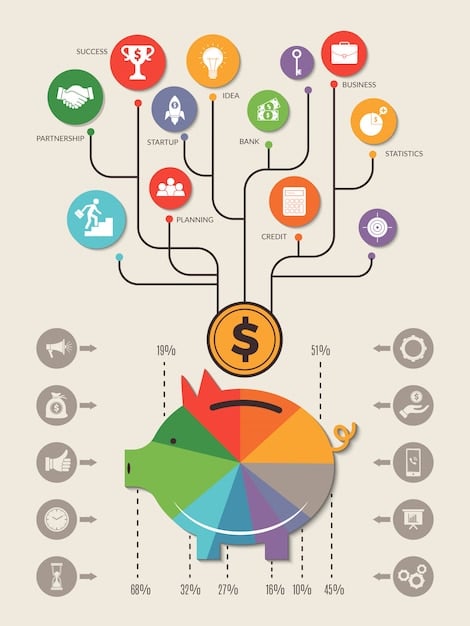SAFE Agreements: A Simple 2025 Guide for US Entrepreneurs

Understanding SAFE (Simple Agreement for Future Equity) agreements is crucial for US entrepreneurs in 2025, offering a streamlined method for raising capital without the complexities of traditional equity or debt financing, making them a popular choice for early-stage startups.
Navigating the world of startup funding can be daunting, especially for first-time entrepreneurs. One common tool in the fundraising landscape is the understanding SAFE agreements: a simple guide for entrepreneurs in 2025. This guide will break down SAFE agreements, their benefits, and how they can help your startup get off the ground.
What is a SAFE Agreement?
A SAFE, or Simple Agreement for Future Equity, is an agreement between an investor and a company that provides rights to the investor for future equity in the company. It’s neither debt nor equity but rather a warrant that converts into equity upon the occurrence of specific events, usually a priced equity round.
Think of it as a promise to give the investor stock in your company at a later date, under certain conditions. This simplifies the early fundraising process, avoiding the complexities and costs associated with valuing the company early on.
Key Features of SAFE Agreements
SAFE agreements come with a few key features that are important to understand before diving in:
- Discount Rate: The investor receives a discount on the price per share compared to later investors.
- Valuation Cap: A maximum valuation at which the SAFE will convert into equity.
- Liquidity Preference: Determines the order in which investors receive their returns in a liquidity event.
- Pro-Rata Rights: The right for the investor to participate in future funding rounds to maintain their ownership percentage.

Understanding these features is critical for both entrepreneurs and investors to ensure that the terms are fair and beneficial for all parties involved. SAFE agreements provide a flexible and efficient way to secure early-stage funding.
The Benefits of SAFE Agreements for Startups
SAFE agreements offer several advantages for startups seeking early-stage funding. They are designed to be simpler and faster than traditional equity financing, reducing legal costs and accelerating the fundraising process.
By postponing the valuation discussion, startups can focus on building their product and generating traction. This allows them to raise capital without the pressure of setting a premature valuation, which can be challenging for early-stage companies.
Speed and Simplicity
SAFE agreements streamline the fundraising process, enabling startups to close deals quickly and efficiently. This is particularly beneficial when time is of the essence.
The standardized documentation reduces the need for extensive legal review, saving both time and money, which can be crucial for startups operating on limited resources.
Avoiding Early Valuation
One of the biggest advantages of SAFE agreements is the ability to avoid setting a valuation too early. This is particularly important for startups in the pre-revenue stage, where valuation can be highly speculative.
- Allows focus on product development and market validation.
- Postpones complex valuation negotiations until more data is available.
- Attracts investors who believe in the long-term potential of the company.
By using SAFE agreements, startups can delay valuation discussions until they have more tangible results, leading to a more accurate and favorable valuation in future funding rounds.
In summary, SAFE agreements offer startups a flexible, efficient, and cost-effective way to raise capital, allowing them to focus on growth and development without getting bogged down in complex negotiations. They provide a win-win scenario for both startups and investors.
Understanding the Risks and Downsides
While SAFE agreements offer numerous benefits, it’s essential to be aware of the potential risks and downsides for both startups and investors. These agreements are not without their drawbacks, and understanding them is crucial for making informed decisions.
For startups, one of the primary risks is the eventual dilution of equity. While SAFE agreements delay the valuation discussion, they ultimately result in the issuance of equity, which can dilute the ownership stake of the founders and early team members.
Dilution of Equity
Equity dilution is a natural consequence of raising capital, but it’s important to manage it carefully. Over time, multiple rounds of funding using SAFE agreements can significantly reduce the founders’ ownership percentage.
Startups need to consider the potential impact of dilution on their long-term control and incentives. It’s also important to communicate transparently with investors about the potential for future dilution.
Uncertainty in Conversion
The conversion of SAFE agreements into equity is contingent upon future events, such as a priced equity round or a liquidity event. This uncertainty can create anxiety for both startups and investors.
- The terms of the conversion may not be as favorable as initially anticipated.
- Delays in raising a priced round can prolong the uncertainty.
- Investors may have limited rights or control until the conversion occurs.

Despite the risks, SAFE agreements remain a popular option for early-stage funding. By understanding the potential downsides and managing them proactively, startups can leverage SAFE agreements to achieve their growth objectives while mitigating the associated risks.
SAFE Agreement Variations: Caps and Discounts
When structuring a understanding SAFE agreements: a simple guide for entrepreneurs in 2025 a valuation cap and discount rate are important terms to consider. They influence the amount of equity an investor will receive upon conversion and can significantly impact the overall economics of the deal.
A valuation cap sets a maximum valuation at which the SAFE will convert into equity. This protects the investor from excessive dilution if the company’s valuation skyrockets before the conversion event. Conversely, a discount rate provides the investor with a discount on the price per share compared to later investors. This compensates the investor for taking on the early-stage risk.
Valuation Caps Explained
A valuation cap is a crucial term in a SAFE agreement that protects investors from paying an exorbitant price for their equity. It acts as a ceiling on the valuation used to calculate the number of shares the investor will receive upon conversion.
For example, if a SAFE agreement has a valuation cap of $10 million, and the company raises a priced round at a $20 million valuation, the SAFE will convert as if the valuation were $10 million. This ensures that the investor receives a larger equity stake than they would have without the cap.
Discount Rates Demystified
A discount rate provides investors with a percentage discount on the price per share compared to the price paid by investors in a later equity round. This compensates them for investing early and taking on more risk.
- Common discount rates range from 10% to 30%.
- The discount is applied to the price per share in the qualified financing.
- Investors benefit from a lower purchase price, increasing their potential returns.
When negotiating SAFE agreements, startups and investors need to carefully consider the appropriate valuation cap and discount rate. These terms play a crucial role in determining the fairness and attractiveness of the deal.
In summary, valuation caps and discount rates are essential components of SAFE agreements that impact the equity stake received by investors. Understanding these terms is crucial for startups looking to raise capital and for investors seeking attractive investment opportunities. Careful consideration of these terms can ensure a mutually beneficial agreement for all parties involved.
Legal and Tax Considerations for SAFE Agreements
Navigating the legal and tax aspects of understanding SAFE agreements: a simple guide for entrepreneurs in 2025 important to ensure compliance and avoid potential pitfalls. Both startups and investors need to understand the legal implications and tax consequences associated with SAFE agreements.
From a legal perspective, SAFE agreements are governed by contract law and are subject to state and federal securities laws. It’s essential to have a clear and well-drafted agreement that accurately reflects the intentions of the parties involved. From a tax perspective, the conversion of a SAFE into equity can have significant tax implications for both the startup and the investor.
Legal Due Diligence
Before entering into a SAFE agreement, startups should conduct thorough legal due diligence to ensure compliance with all applicable laws and regulations. This includes reviewing the terms of the agreement, assessing the potential risks, and seeking advice from experienced legal counsel.
Investors should also conduct their own legal due diligence to verify the startup’s compliance with securities laws and to understand the potential legal risks associated with the investment.
Tax Implications
The tax implications of SAFE agreements can be complex and depend on various factors, such as the structure of the agreement, the timing of the conversion, and the tax status of the investor.
- Consult with a tax advisor to understand the potential tax consequences.
- Comply with all applicable tax reporting requirements.
- Consider the potential impact of SAFE agreements on future tax planning.
Working with legal and tax professionals is essential to navigate the complexities of SAFE agreements and to ensure that both startups and investors are protected. By addressing these considerations proactively, stakeholders can mitigate risks and optimize the benefits of SAFE agreements.
Addressing these considerations proactively can mitigate risks and optimize the benefits of the SAFE agreements. Ultimately, careful attention to legal and tax matters can contribute to a successful and compliant fundraising process.
SAFE Agreements in 2025: Trends and Predictions
Looking ahead to 2025, several trends and predictions are shaping the landscape of understanding SAFE agreements: a simple guide for entrepreneurs in 2025. The continued growth of the startup ecosystem, coupled with advancements in technology and changes in regulatory frameworks, is influencing the use and structure of SAFE agreements.
One key trend is the increasing standardization of SAFE agreements, with more startups and investors adopting standardized templates developed by organizations like Y Combinator. This standardization reduces legal costs and accelerates the fundraising process. Another trend is the growing use of SAFE agreements in diverse industries, beyond the traditional tech sector.
Increased Standardization
The standardization of SAFE agreements is making them more accessible and easier to understand for both startups and investors. Standardized templates provide a common framework, reducing the need for extensive customization and legal review.
Organizations like Y Combinator have played a significant role in promoting the adoption of standardized SAFE agreements, which has led to greater efficiency and transparency in the early-stage funding market.
Expansion Across Industries
While SAFE agreements were initially popular in the tech industry, their use is expanding to other sectors, such as healthcare, education, and consumer goods. This reflects the growing recognition of the benefits of SAFE agreements as a flexible and efficient fundraising tool.
- Healthcare startups are using SAFE agreements to fund early-stage research and development.
- Educational startups are leveraging SAFE agreements to expand their technology platforms.
- Consumer goods companies are utilizing SAFE agreements to finance product launches and marketing campaigns.
In summary, in 2025 and beyond, SAFE agreements are expected to become even more prevalent and versatile, playing a critical role in the startup ecosystem. As the funding landscape evolves, SAFE agreements will continue to adapt and innovate to meet the changing needs of startups and investors.
400px; margin-bottom: 20px; margin-top: 20px;”>
Key Points
Brief Description
🚀 Understanding SAFE agreements are crucial for startups seeking early-stage funding.
✅ SAFE agreements helps entrepreneurs raise capital without the complexities of traditional equity or debt financing.
💰 SAFE agreements offers a simpler and faster fundraising process.
💡 Valuation caps and discount rates are essential components of SAFE agreements.
frequently asked questions
What is a SAFE agreement and how does it work?
▼
A SAFE (Simple Agreement for Future Equity) agreement is an agreement between an investor and a company that provides rights to the investor for future equity in the company, typically converting during a priced equity round.
What are the key benefits of using SAFE agreements for startups?
▼
SAFE agreements offer speed and simplicity in fundraising, allowing startups to avoid early valuation discussions and focus on product development and market validation.
What are the risks and downsides of SAFE agreements?
▼
The primary risks include potential dilution of equity and uncertainty in conversion. It’s important to manage dilution and communicate transparently with investors about future funding rounds.
How do valuation caps and discount rates impact SAFE agreements?
▼
A valuation cap sets a maximum valuation for conversion, protecting investors from excessive dilution, while a discount rate provides a reduced price per share compared to later investors, compensating them for early-stage risk.
What legal and tax considerations should startups be aware of when using SAFE agreements?
▼
Startups should conduct legal due diligence to ensure compliance with securities laws and consult a tax advisor to understand the potential tax consequences of SAFE agreements and their conversion into equity.
In conclusion, **understanding SAFE agreements: a simple guide for entrepreneurs in 2025** provide a modern, streamlined approach to early-stage funding, offering both benefits and risks. By understanding the nuances of these agreements, entrepreneurs can make informed decisions and navigate the fundraising landscape with confidence, setting the stage for long-term success.
Read more content





